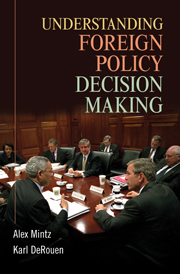Book contents
- Frontmatter
- Contents
- Acknowledgments
- PART ONE INTRODUCTION
- PART TWO THE DECISION ENVIRONMENT
- PART THREE MODELS OF DECISION MAKING
- 4 The Rational Actor Model
- 5 Alternatives to the Rational Actor Model
- PART FOUR DETERMINANTS OF FOREIGN POLICY DECISION MAKING
- PART FIVE MARKETING FOREIGN POLICY
- PART SIX CONCLUSION
- Appendix: Foreign Policy Simulation and Exercise
- References
- Index
4 - The Rational Actor Model
Published online by Cambridge University Press: 05 June 2012
- Frontmatter
- Contents
- Acknowledgments
- PART ONE INTRODUCTION
- PART TWO THE DECISION ENVIRONMENT
- PART THREE MODELS OF DECISION MAKING
- 4 The Rational Actor Model
- 5 Alternatives to the Rational Actor Model
- PART FOUR DETERMINANTS OF FOREIGN POLICY DECISION MAKING
- PART FIVE MARKETING FOREIGN POLICY
- PART SIX CONCLUSION
- Appendix: Foreign Policy Simulation and Exercise
- References
- Index
Summary
In this chapter, we look at models and approaches to FPDM that proceed from rational actor assumptions. We examine the expected utility model of war and some game-theoretic models such as the Prisoner's Dilemma, Chicken Game, and the Tit-for-Tat strategy.
THE RATIONAL ACTOR MODEL
The rational actor model is a linchpin of FPDM. Paul MacDonald (2003, 551) contends that many see it “as the most plausible candidate for a universal theory of political and social behavior, whose simple and intuitively plausible assumptions hold the promise of unifying the diverse subfields of political science.” Whereas many scholars criticize the model, others strongly defend it. Before a model can be proposed based on its tenets or its underlying assumptions criticized, we must first understand it.
A rational approach extensively used in foreign policy analysis today, expected utility theory (EUT) sprang from the work of von Neumann and Morgenstern in the 1940s. The approach has its roots in microeconomics. The decision maker is assumed to be able to rank preferences “according to the degree of satisfaction of achieving these goals and objectives” (Sage 1990, 233). The rational actor is also expected to be able to identify alternatives and their consequences and to select from these alternatives in an effort to maximize satisfaction. In this setting, the rational economic decision maker is expected to be able to access a set of objectives and goals.
- Type
- Chapter
- Information
- Understanding Foreign Policy Decision Making , pp. 57 - 67Publisher: Cambridge University PressPrint publication year: 2010
- 3
- Cited by



